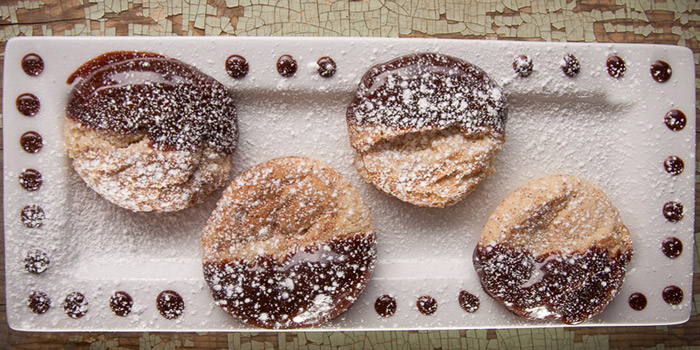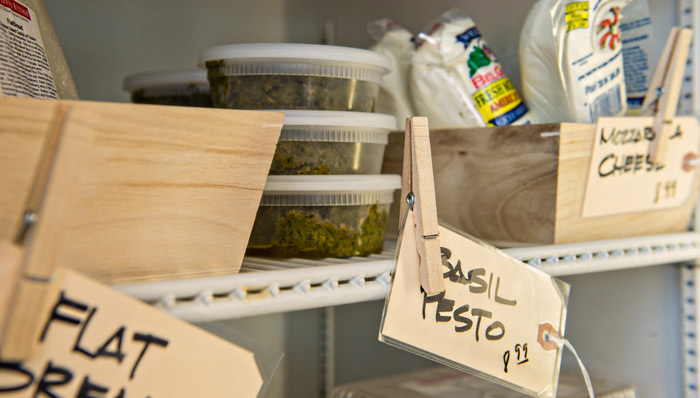Profits, profits, profits…that’s what it’s all about in the catering world.
Note that I did not say revenue, revenue, revenue. I know so many caterers who have huge gross sales but tiny net sales. In the food industry, yearly net sales average nationally about five percent. But catering companies are not “average food companies.” If you are making the profits you should, you can expect yearly net profits of more than 12 percent.

This image of white chocolate dipped cookies provides a good representation of he importance of product presentation.
Cost per serving
There are a few ways caterers can capitalize on what they know, but first you must make every dollar of profit possible. How? Use accurate recipe costing cards. Recipe costing cards break down each recipe by ingredient and the cost associated with each ingredient to get the total cost to make that recipe for serving.
This can be a daunting task for caterers because you probably have hundreds or thousands of recipes, whereas a restaurant only has a handful in comparison. Why the difference? Because caterers usually have several versions of each recipe.
For example, client number one wants New York strip sliders seasoned with kosher salt and pepper and served with jerk aioli on a baguette. Client two wants New York strip sliders with garlic and horseradish whipped cream on a fresh homemade roll. The possibilities go on and on and on.
In my catering company we have more than 1,700 recipes currently broken down into recipe costing cards, and we add new recipes every month. But most importantly, each of our recipes is updated monthly with current costs from our vendors.
Every time I speak to a group of caterers or restaurant owners, I always ask for a show of hands as to how many people have all of their recipes broken down by cost. If there are 100 in the room, maybe two will raise their hands. Next, I ask if they update them monthly and 99 percent of the time all hands go down. You can see how this can make a difference in comparison to your restaurant competition.
You have the edge
After putting this system in place, you can capitalize on the huge edge you have over restaurants that offer catering. You have more experience in knowing what is expected at a catered event, flat out. For example:
• Décor – part of catering the right way, the expected way, is visual. A client wants to see presentation of food. Many times a restaurant caterer just wants to drop it and go. Why? They know how to present food on a plate but most do not know how to present food for an event.
• Staff – the bartender at a restaurant needs to be outgoing, friendly, gregarious, and entertaining so he can upsell to his customers and make more money for the restaurant and tips for himself. For a private social or corporate catered event, you do not want that same bartender at that event. He or she needs to be a talented friendly bartender who blends in with the furniture. And you definitely don’t want them placing a tip jar on the bar!
• Turnkey – as a caterer you have checklists in place and can handle the details of the event. In other words you offer turnkey event services. I have yet to meet a restaurant owner that offers turnkey service for a catered event.
• Title – you can win the competition by being solely a caterer. Restaurants have to overcome preconceptions. For example, most people assume themed restaurants can only cater the kind of food featured on their menu, such as BBQ, Italian, or Mexican cuisine. These restaurants may have a chef that can produce the most diverse and delicious menu of hors d’oeuvres in the entire city, but most people are going to assume that they can only cater what is on their restaurant menu and head straight for a traditional caterer instead.
Another big way to keep some of the catering profits to yourself is to sell retail to your existing clients—or what I call take-home catering.

The Festive Kitchen, a take-home catering brick and mortar, offers delicious grab and go items such as pesto, flatbread, and mozzerella.
To go
Think about it, how many parties can most of your clients afford to have in one year? Not many. But they do need to eat regularly and a lot of people don’t want to cook. If they don’t cook it, where are they going to buy it? They get tired of going to a restaurant and many times a restaurant costs more. So, why can’t you, their favorite caterer, whose food they crave, provide them food they can have at home?
You must do this NOW. I started selling retail 13 years ago and it was one of the best business decisions I have ever made. I can guarantee that if you do the same, you will take profits right out of the bank accounts of local restaurants in your area.
Don’t be intimidated by more restaurants entering the catering world. Restaurants are entering “your” territory, and you can beat them in bringing more profits to your company’s bottom line. Capitalize on your differences!
Get Fresh November 2015
eNews November 2015




